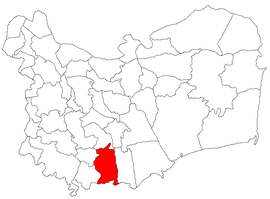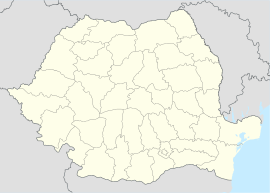world.wikisort.org - Romania
Baia is a commune in Tulcea County, Northern Dobruja, Romania.
Baia | |
|---|---|
Commune | |
 Location in Tulcea County | |
 Baia Location in Romania | |
| Coordinates: 44°43′N 28°40′E | |
| Country | Romania |
| County | Tulcea |
| Subdivisions | Baia, Camena, Caugagia, Ceamurlia de Sus, Panduru |
| Government | |
| • Mayor (2020–2024) | Mugurel Marșavela[1] (PSD) |
| Area | 198.29 km2 (76.56 sq mi) |
| Population (2011)[2] | 4,758 |
| • Density | 24/km2 (62/sq mi) |
| Time zone | EET/EEST (UTC+2/+3) |
| Postal code | 827005 |
| Vehicle reg. | TL |
| Website | www |
Villages
The commune includes five villages:
- Baia (Hamangia until 1929, Turkish: Hamamci)
- Camena
- Caugagia (Turkish: Kavgaci)
- Ceamurlia de Sus (Yeni Kazak until ca. 1855)
- Panduru (Potur until 1929)
History
In 1953, archaeological excavations on a site along the Lake Golovița, near Baia, led to the discovery of a new Middle Neolithic culture, named after the commune. Further research has shown that the culture, with Mediterranean origins, extended across Dobruja and North-Eastern Bulgaria. The culture's most notable artefact is an anthropomorphic statuette in terra cotta, known as The Thinker, which was discovered at Cernavodă.
References
- "Results of the 2020 local elections". Central Electoral Bureau. Retrieved 14 June 2021.
- "Populaţia stabilă pe judeţe, municipii, oraşe şi localităti componenete la RPL_2011" (XLS). National Institute of Statistics.
Текст в блоке "Читать" взят с сайта "Википедия" и доступен по лицензии Creative Commons Attribution-ShareAlike; в отдельных случаях могут действовать дополнительные условия.
Другой контент может иметь иную лицензию. Перед использованием материалов сайта WikiSort.org внимательно изучите правила лицензирования конкретных элементов наполнения сайта.
Другой контент может иметь иную лицензию. Перед использованием материалов сайта WikiSort.org внимательно изучите правила лицензирования конкретных элементов наполнения сайта.
2019-2025
WikiSort.org - проект по пересортировке и дополнению контента Википедии
WikiSort.org - проект по пересортировке и дополнению контента Википедии
